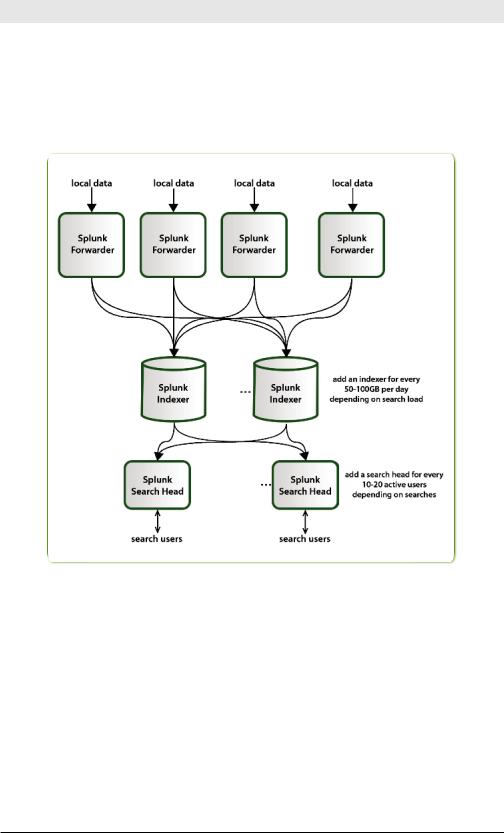
exploring-splunk
.pdf
Appendix E: Splunk Quick Reference Guide
Event Types
Event types are dynamic tags attached to an event, if it matches the search definition of the event type. For example, if you define an event type called problem with a search definition of error OR warn OR fatal OR fail, whenever a search result contains error, warn, fatal, or fail, the event has an eventtype field/value with eventtype=problem. If you were searching for login, the logins with problems would be annotated with eventtype=problem. Event types are cross-referenced searches that categorize events at search time.
Reports and Dashboards
Search results with formatting information (e.g., as a table or chart) are informally referred to as reports, and multiple reports can be placed on a common page, called a dashboard.
Apps
Apps are collections of Splunk configurations, objects, and code. Apps allow you to build different environments that sit on top of Splunk. You can have one app for troubleshooting email servers, one app for web analysis, and so on.
Permissions/Users/Roles
Saved Splunk objects, such as savedsearches, eventtypes, reports, and tags, enrich your data, making it easier to search and understand. These objects have permissions and can be kept private or shared with other users by roles (such as admin, power, or user). A role is a set of capabilities that you define, such as whether a particular role is allowed to add data or edit a report. Splunk with a free license does not support user authentication.
Transactions
A transaction is a set of events grouped into one for easier analysis. For example, because a customer shopping online generates multiple web access events with the same SessionID, it may be convenient to group those events into one transaction. With one transaction event, it’s easier to generate statistics such as how long shoppers shopped, how many items they bought, which shoppers bought items and then returned them, and so on.
139

Exploring Splunk
Forwarder/Indexer
A forwarder is a version of Splunk that allows you to send data to a central Splunk indexer or group of indexers. An indexer provides indexing capability for local and remote data.
SPL
A search is a series of commands and arguments, chained together with pipe character (|) that takes the output of one command and feeds it into the next command.
search-args | cmd1 cmd-args | cmd2 cmd-args | ...
Search commands are used to take indexed data and filter unwanted information, extract more information, calculate values, transform them, and statistically analyze results. The search results retrieved from the index can be thought of as a dynamically created table. Each search command redefines the shape of that table. Each indexed event is a row, with
140

Appendix E: Splunk Quick Reference Guide
columns for each field value. Columns include basic information about the data and data dynamically extracted at search-time.
At the head of each search is an implied search-the-index-for-events command, which can be used to search for keywords (e.g., error), boolean expressions (e.g., (error OR failure) NOT success), phrases (e.g., “database error”), wildcards (e.g., fail* matches fail, fails, and failure), field values (e.g., code=404), inequality (e.g., code!=404 or code>200), a field having any value or no value (e.g., code=* or NOT code=*). For example, the search:
sourcetype=”access_combined” error | top 10 uri
retrieves indexed access_combined events from disk that contain the term error (ANDs are implied between search terms), and then for those events, reports the top 10 most common URI values.
Subsearches
A subsearch is an argument to a command that runs its own search, returning those results to the parent command as the argument value. Subsearches are enclosed in square brackets. For example, this command finds all syslog events from the user with the last login error:
sourcetype=syslog [search login error | return user]
Note that the subsearch returns one user value because by default the return command returns one value, although there are options to return more (e.g., | return 5 user).
Relative Time Modifiers
Besides using the custom-time ranges in the user interface, you can specify in your search the time ranges of retrieved events with the latest and earliest search modifiers.The relative times are specified with a string of characters that indicate amount of time (integer and unit) and, optionally, a “snap to” time unit:
[+|-]<time_integer><time_unit>@<snap_time_unit>
For example, error earliest=-1d@d latest=-1h@h retrieves events containing error that from yesterday (snapped to midnight) to the last hour (snapped to the hour).
Time Units: Specified as second (s), minute (m), hour (h), day (d), week (w), month (mon), quarter(q), or year (y). The preceding value defaults to 1 (i.e., m is the same as 1m).
141

Exploring Splunk
Snapping: Indicates the nearest or latest time to which your time amount rounds down. Snapping rounds down to the most recent time that is not after the specified time. For example, if it’s 11:59:00 and you ”snap to” hours (@h), you snap to 11:00, not 12:00. You can snap to a day of the week, too; use @w0 for Sunday, @w1 for Monday, and so on.
COMMON SEARCH COMMANDS
COMMAND |
|
chart/timechart |
Returns results in a tabular output for (time series) |
|
charting. |
|
|
dedup |
Removes subsequent results that match. |
|
|
eval |
Calculates an expression. (See EVAL FUNCTIONS |
|
table.) |
|
|
fields |
Removes fields from search results. |
|
|
head/tail |
Returns the first/last N results. |
|
|
lookup |
Adds field values from an external source. |
|
|
rename |
Renames a specified field; wildcards can be used to |
|
specify multiple fields. |
replace |
Replaces values of specified fields with a specified |
|
new value. |
rex |
Specifies regular expression to use to extract fields. |
search |
Filters results to those that match the search expres- |
|
sion. |
sort |
Sorts search results by the specified fields. |
stats |
Provides statistics, grouped optionally by fields. |
top/rare |
Displays the most/least common values of a field. |
|
|
transaction |
Groups search results into transactions. |
|
|
Optimizing Searches
The key to fast searching is to limit the data to read from disk to an absolute minimum and then to filter that data as early as possible in the search so that processing is done on the smallest amount of data.
Partition data into separate indexes if you’ll rarely perform searches across multiple types of data. For example, put web data in one index and firewall data in another.
142

Appendix E: Splunk Quick Reference Guide
More tips:
•Search as specifically as you can (fatal_error, not *error*).
•Limit the time range (e.g., -1h not -1w).
•Filter out unneeded fields as soon as possible.
•Filter out results as soon as possible before calculations.
•For report generating searches, use the Advanced Charting view, and not the Timeline view, which calculates timelines.
•Turn off the Field Discovery switch when not needed.
•Use summary indexes to precalculate commonly used values.
•Make sure your disk I/O is the fastest you have available.
SEARCH EXAMPLES
Filter Results
Filter results to only include those |
… | search fail status=0 |
|
with fail in their raw text and sta- |
|
|
tus=0. |
|
|
|
|
|
Remove duplicates of results with the |
… | dedup host |
|
same host value. |
|
|
|
|
|
Keep only search results whose _raw |
… | regex _raw="(?<!\d)10.\ |
|
field contains IP addresses in the |
d{1,3}\.\d{1,3}\.\d{1,3} |
|
(?!\d)" |
||
nonroutable class A (10.0.0.0/8). |
||
|
||
|
|
Group Results
Cluster results together, sort by their |
… | cluster t=0.9 |
|
cluster_count values, and then |
showcount=true | sort limit=20 |
|
-cluster_count |
||
return the 20 largest clusters (in data |
||
|
||
size). |
|
|
|
|
|
Group results that have the same host |
… | transaction host cookie |
|
and cookie, occur within 30 seconds |
maxspan=30s maxpause=5s |
|
|
||
of each other, and do not have a |
|
|
pause greater than 5 seconds be- |
|
|
tween each event into a transaction. |
|
|
|
|
|
Group results with the same IP ad- |
… | transaction clien- |
|
dress (clientip) and where the first |
tip startswith="signon" |
|
result contains signon and the last |
endswith="purchase" |
|
|
||
result contains purchase. |
|
|
|
|
143

Exploring Splunk
Order Results
Return the first 20 results. |
… | head 20 |
Reverse the order of a result set. |
… | reverse |
|
|
Sort results by ip value (in ascend- |
… | sort ip, -url |
ing order) and then by url value (in |
|
descending order). |
|
|
|
Return the last 20 results (in reverse |
… | tail 20 |
order). |
|
|
|
Reporting
Return events with uncommon |
… | anomalousvalue |
values. |
action=filter pthresh=0.02 |
|
|
|
|
Return the maximum "delay" by |
… | chart max(delay) by size |
"size", where "size" is broken down |
bins=10 |
into a maximum of 10 equal sized |
|
buckets. |
|
|
|
Return max(delay) for each value of |
… | chart max(delay) over foo |
foo split by the value of bar. |
by bar |
|
|
|
|
Return max(delay) for each value of |
… | chart max(delay) over foo |
foo. |
|
|
|
Remove all outlying numerical val- |
… | outlier |
ues. |
|
|
|
Remove duplicates of results with the |
… | stats dc(host) |
same host value and return the total |
|
count of the remaining results. |
|
|
|
Return the average for each hour of |
… | stats avg(*lay) by date_ |
any unique field that ends with the |
hour |
|
|
string lay (such as delay, xdelay, and |
|
relay). |
|
Calculate the average value of CPU |
… | timechart span=1m avg(CPU) |
each minute for each host. |
by host |
|
|
Create a timechart of the count of |
… | timechart count by host |
from web sources by host. |
|
Return the 20 most common values |
… | top limit=20 url |
of the url field. |
|
Return the least common values of |
… | rare url |
the url field. |
|
144

|
Appendix E: Splunk Quick Reference Guide |
|
|
|
|
|
|
|
|
Add Fields |
|
|
Set velocity to distance / time. |
… | eval velocity=distance/ |
|
|
time |
|
Extract from and to fields using |
… | rex field=_raw "From: |
|
regular expressions. If a raw event |
(?<from>.*) To: (?<to>.*)" |
|
|
|
|
contains From: Susan To: David, |
|
|
then from=Susan and to=David. |
|
|
Save the running total of count in a |
… | accum count as total_count |
|
field called total_count. |
|
|
For each event where count exists, |
… | delta count as countdiff |
|
compute the difference between |
|
|
count and its previous value and |
|
|
store the result in countdiff. |
|
|
Filter Fields |
|
|
Keep the host and ip fields, and |
… | fields + host, ip |
|
display them in the order: host, ip. |
|
|
Remove the host and ip fields. |
… | fields - host, ip |
|
|
|
|
Modify Fields |
|
|
Keep the host and ip fields, and dis- |
… | fields + host, ip |
|
play them in the order: host, ip. |
|
|
|
|
|
Remove the host and ip fields. |
… | fields - host, ip |
|
|
|
|
Multivalued Fields |
|
|
Combine the multiple values of the |
… | nomv recipients |
|
recipients field into one value. |
|
|
|
|
|
Separate the values of the |
… | makemv delim="," recipi- |
|
recipients field into multiple field |
ents | top recipients |
|
values, displaying the top recipients. |
|
|
|
|
|
Create new results for each value of |
… | mvexpand recipients |
|
the multivalue field recipients. |
|
|
|
|
|
Combine each result that is identical |
… | fields EventCode, Catego- |
|
except for its RecordNumber, setting |
ry, RecordNumber |
|
| mvcombine delim=”,” Record- |
|
|
RecordNumber to a multivalued field |
|
|
with all the varying values. |
Number |
|
|
|
|
|
|
|
Find the number of recipient |
… | eval to_count = |
|
values. |
mvcount(recipients) |
|
|
|
|
|
|
|
Find the first email address in the |
… | eval recipient_first = |
|
recipient field. |
mvindex(recipient,0) |
|
|
|
145

Exploring Splunk
Find all recipient values that end in |
… | eval netorg_recipients |
|
.net or .org |
= mvfilter(match(recipient, |
|
"\.net$") OR match(recipient, |
||
|
||
|
"\.org$")) |
|
|
|
|
Find the combination of the values of |
… | eval newval = |
|
foo, "bar", and the values of baz. |
mvappend(foo, "bar", baz) |
|
|
||
Find the index of the first recipient |
… | eval orgindex = |
|
value that matches "\.org$" |
mvfind(recipient, "\.org$") |
|
|
||
|
|
Lookup Tables
Look up the value of each event's |
… | lookup usertogroup user |
user field in the lookup table |
output group |
|
|
usertogroup, setting the event’s |
|
group field. |
|
Write the search results to the lookup |
… | outputlookup users.csv |
file users.csv. |
|
|
|
Read in the lookup file users.csv |
… | inputlookup users.csv |
as search results. |
|
|
|
EVAL FUNCTIONS
The eval command calculates an expression and puts the resulting value into a field (e.g., “...| eval force = mass * acceleration”). The following table lists the functions eval understands, in addition to basic arithmetic operators (+ - * / %), string concatenation (e.g., ‘...| eval name = last . “, “ . last’), and Boolean operations (AND OR NOT
XOR < > <= >= != = == LIKE).
Eval Functions Table
Function |
Description |
Examples |
abs(X) |
Returns the absolute |
abs(number) |
|
value of X. |
|
|
|
|
case(X,"Y",…) |
Takes pairs of argu- |
case(error == 404, |
|
ments X and Y, where X |
"Not found", error |
|
== 500,"Internal |
|
|
arguments are Boolean |
|
|
Server Error", er- |
|
|
expressions that, when |
|
|
ror == 200, "OK") |
|
|
evaluated to TRUE, re- |
|
|
|
|
|
turn the corresponding |
|
|
Y argument. |
|
|
|
|
ceil(X) |
Ceiling of a number X. |
ceil(1.9) |
|
|
|
cidrmatch("X",Y) |
Identifies IP addresses |
cidrmatch("123.132. |
|
that belong to a subnet. |
32.0/25",ip) |
|
|
|
|
|
|
146

Appendix E: Splunk Quick Reference Guide
coalesce(X,…) |
Returns the first value |
coalesce(null(), |
|
that is not null. |
"Returned val", |
|
null()) |
|
|
|
|
|
|
|
exact(X) |
Evaluates an expres- |
exact(3.14*num) |
|
sion X using double |
|
|
precision floating point |
|
|
arithmetic. |
|
|
|
|
exp(X) |
Returns eX. |
exp(3) |
|
|
|
floor(X) |
Returns the floor of a |
floor(1.9) |
|
number X. |
|
if(X,Y,Z) |
If X evaluates to TRUE, |
if(error==200, |
|
the result is the second |
"OK", "Error") |
|
|
|
|
argument Y. If X evalu- |
|
|
ates to FALSE, the result |
|
|
evaluates to the third |
|
|
argument Z. |
|
isbool(X) |
Returns TRUE if X is |
isbool(field) |
|
Boolean. |
|
isint(X) |
Returns TRUE if X is an |
isint(field) |
|
integer. |
|
isnotnull(X) |
Returns TRUE if X is not |
isnotnull(field) |
|
NULL. |
|
isnull(X) |
Returns TRUE if X is |
isnull(field) |
|
NULL. |
|
isnum(X) |
Returns TRUE if X is a |
isnum(field) |
|
number. |
|
|
|
|
isstr() |
Returns TRUE if X is a |
isstr(field) |
|
string. |
|
|
|
|
len(X) |
This function returns the |
len(field) |
|
character length of a |
|
|
string X. |
|
|
|
|
like(X,"Y") |
Returns TRUE if and |
like(field, "foo%") |
|
only if X is like the |
|
|
SQLite pattern in Y. |
|
|
|
|
ln(X) |
Returns the natural log |
ln(bytes) |
|
of X. |
|
|
|
|
log(X,Y) |
Returns the log of the |
log(number,2) |
|
first argument X using |
|
|
the second argument Y |
|
|
as the base. Y defaults |
|
|
to 10. |
|
|
|
|
147

Exploring Splunk
lower(X) |
Returns the lowercase |
lower(username) |
|
of X. |
|
|
|
|
ltrim(X,Y) |
Returns X with the char- |
ltrim(" ZZZabcZZ ", |
|
acters in Y trimmed from |
" Z") |
|
the left side. Y defaults |
|
|
to spaces and tabs. |
|
|
|
|
match(X,Y) |
Returns True, if X match- |
match(field, |
|
es the regex pattern Y. |
"^\d{1,3}\.\d$") |
|
|
|
|
|
|
max(X,…) |
Returns the greater of |
max(delay, mydelay) |
|
the two values. |
|
|
|
|
md5(X) |
Returns the MD5 hash |
md5(field) |
|
of string value X. |
|
|
|
|
min(X,…) |
Returns the min. |
min(delay, mydelay) |
|
|
|
mvcount(X) |
Returns the number of |
mvcount(multifield) |
|
values of X. |
|
mvfilter(X) |
Filters a multivalued |
mvfilter(match(emai |
|
field based on the Bool- |
l, "net$")) |
|
ean expression X. |
|
mvindex(X,Y,Z) |
Returns a subset of the |
mvindex( multi- |
|
multivalued field X from |
field, 2) |
|
start position (zero- |
|
|
based) Y to Z (optional). |
|
mvjoin(X,Y) |
Given a multivalued |
mvjoin(foo, ";") |
|
field X and string delim- |
|
|
iter Y, joins the individu- |
|
|
al values of X using Y. |
|
now() |
Returns the current |
now() |
|
time, represented in |
|
|
Unix time. |
|
null() |
Takes no arguments and |
null() |
|
returns NULL. |
|
nullif(X,Y) |
Given two arguments, |
nullif(fieldA, |
|
fields X and Y, returns |
fieldB) |
|
|
|
|
X if the arguments are |
|
|
different; returns NULL, |
|
|
otherwise. |
|
|
|
|
pi() |
Returns the constant pi. |
pi() |
|
|
|
pow(X,Y) |
Returns XY. |
pow(2,10) |
|
|
|
148
